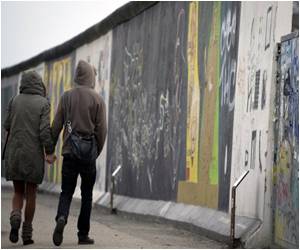
Ten months later, it would be gone, figuratively at least, and people armed with chisels would gleefully set to work literally chipping away at the graffiti-covered concrete slabs that had cruelly divided Berliners.
"Aspirations of freedom, of democracy and of unity were so strong, it was necessary to make the traces of the thing recalling this terrible history disappear," said Anna Kaminsky, who compiled the photographic book, "Die Berliner Mauer In Der Welt" (The Berlin Wall in the World).
But after the turn of the millennium Berlin city officials became mindful that what still remained of the Cold War symbol should be preserved as a historical monument.
The so-called East Side Gallery, which artists covered with murals in early 1990 including the famous "Fraternal Kiss" depicting Soviet leader Leonid Brezhnev and Honecker, is the longest remaining stretch of Wall, at 1.3 kilometres (nearly one mile).
The threatened removal of a segment of that stretch as part of development plans nearby last year sparked a major opposition campaign.
Advertisement
Hundreds of often brightly-coloured and weighty segments of the Wall are now scattered around the world, recalling "victory over the division of the world and the fight for liberty and democracy", Kaminsky said.
Advertisement
French painter Thierry Noir, known for brightly-coloured, big-lipped figures, is credited with being the first artist to have painted the Wall as early as 1984.
Noir is part of a project based on the banks of Berlin's Spree river which offers people the chance to decorate and own an original 3.6-metre (12-foot) high panel of the Wall by first reserving it online, daubing it in paint and finally buying it or selling it on.
"You're totally free to paint what you want, everyone has their personal history with the Wall," the head of the project, Elmer Prost, told AFP.
The organisation behind the scheme receives a third of the sale price, set at a minimum of 1,500 euros ($1,860).
"Before, one was painting it to make it fall. Now one paints the Wall to preserve it like a tribute to Europe's re-found freedom," Noir told AFP.
"It's quite strange," he told AFP, adding: "It wasn't a work of art, it was a killing machine."
At least 389 people lost their lives trying to escape communist East Germany, according to an official toll, although victims groups put the figure much higher.
Four panels of the Berlin Wall have just been erected in South Korea as a symbolic appeal for reunification of the peninsula.
Others stand in Hollywood, outside the United Nations, the European Court of Human Rights in Strasbourg, or still the Ronald Reagan Library in Simi Valley, California, in tribute to the ex-US president who famously challenged his Soviet counterpart Mikhail Gorbachev, saying: "Mr Gorbachev, tear down this wall!".
And soon a Wall segment is due to be installed in Bratislava to commemorate the 1989 "Velvet Revolution" that toppled Communism in then-Czechoslovakia.
Source-AFP









